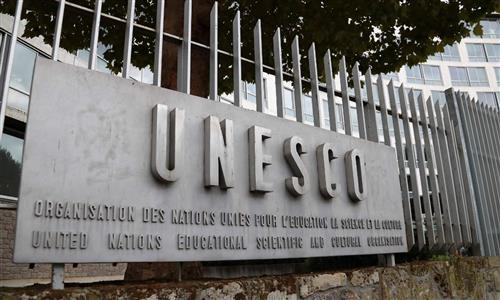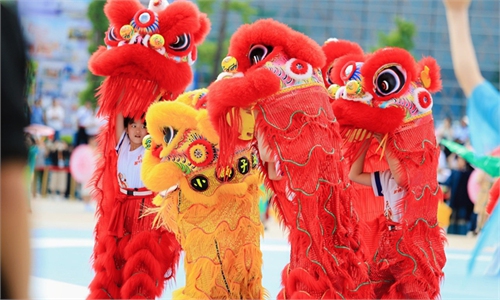ARTS / CULTURE & LEISURE
International Festival of ICH brings rich textures to Chengdu

A dragon dance is performed at the 9th International Festival of ICH in Chengdu, Sichuan Province, on May 28, 2025. Photo: Courtesy of the organizational committee of the festival
At the heart of an international handicraft exhibition at the 9th International Festival of Intangible Cultural Heritage (ICH) that kicked off on Wednesday in Chengdu city, Southwest China's Sichuan Province, a striking installation co-created by weavers from 11 countries across Asia, Africa, Oceania and Europe wowed attendees.
Using natural materials such as rattan and willow, the collaborative work embodied both the tactile language of craftsmanship and the dialogue among artisans from around the world on intangible cultural heritage - marking one of the highlights of the festival.
Among the contributors was Chengdu's Huaiyuan rattan weaving tradition, with national-level inheritor Li Zhihui and his team giving a demonstration on site. Organizers described the installation as a metaphor for co-existence.
President of the Polish wicker weaving association, Maciej Pawlak, was one of the creators of the installation. During the collaboration, he was slightly concerned about the language barrier - he only spoke Polish at first - but he quickly realized that "we didn't need words to understand each other."
"I immediately found that the language barrier didn't matter at all. The people that worked on this piece are like a family," Pawlak told the Global Times on Wednesday.
This echoes his feelings about Chengdu, as this is his first trip to China. "I felt a sense of curiosity and warmth. People here are very passionate and friendly," Pawlak noted. His fascination has extended beyond weaving to the city itself: "I'm also interested in Chengdu's greenery and urban planning. It really has a special feel."
Themed "Promoting Exchange and Mutual Appreciation, Spurring Vitality of Inheritance, Sharing a Better Life," the festival featured nearly 600 representative intangible heritage items from 60 countries and regions, showcasing global achievements in the safeguarding and promotion of intangible cultural heritage. The event will run till June 3, according to the organizers.
For the first time, it introduced a new mechanism featuring a Country of Honor in Malaysia and Cities of Honor in Penang in Malaysia, Chiang Mai in Thailand, Bari in Italy, and Algiers in Algeria, highlighting the mutual appreciation and exchange of different civilizations in the world.
In 2020, the joint nomination by China and Malaysia of "Wang-chuan ceremony, rituals, and related practices for maintaining the sustainable connection between man and the ocean" was inscribed on the UNESCO's Representative List of the Intangible Cultural Heritage of Humanity.
Joyful celebration
Since its inception in 2007, the biennial event has evolved into a key global platform for showcasing and exchanging intangible cultural heritage practices. It is the only festival in China continuously co-organized by UNESCO.
Another notable work that highlights global collaboration and public participation is named "Scenery on the Road," a collaboration between a Polish designer, and students and faculty from the Chengdu University of Technology. Inspired by the Silk Road and the Amber Road, the piece uses materials such as metal foil and resin to depict a flowing landscape.
Commenting on ICH, Pawlak emphasized the power of cross-cultural exchange and also extended an invitation to Chinese artisans to join the wicker weaving festival in Poland.
"The most important thing is training and providing a platform for people in this craft to come together. Only by observing each other can we learn and share techniques," said Pawlak.
He also noted that weaving is a deeply human skill. "It can't be done by machines or digital technology - it depends on the hands and the person."
Italian glass craftsman Mauro Vianello from Venice, is another participant in the international exhibition at the festival. He told the Global Times that he drew a lot of inspiration from the giant panda, Sichuan's unique animal, and hopes to create more glasswork based on panda elements.

A woman views exhibits at the 9th International Festival of Intangible Cultural Heritage (ICH) in Chengdu, Sichuan Province. Photo: Courtesy of the organizational committee of the festival
Public engagementThe festival in Chengdu highlighted the depth and diversity of Chinese ICH with some 400 practitioners showcasing their skills. A major exhibition themed "time" explored how traditional Chinese knowledge systems are embedded in seasonal rhythms.
To drive public engagement in this year's festival launched heritage-themed activities across 288 communities in 183 districts and counties throughout Sichuan.
Coinciding with the Dragon Boat Festival, happening between May 31 to June 2 this year, a series of cultural events such as dragon boat races, bamboo and rattan culture week, and traditional Chinese medicine clinics and Qionglai liquor tasting will be held.
To capture the dynamic spirit of ICH in modern times, internet influencers such as Li Ziqi and other youths were invited to join the parade at the opening ceremony in Chengdu.
Lin Xiyue, a 9-year-old girl, who performed the lion dance on Wednesday, told the Global Times that though she had attended many performances, this one felt different. "I am very happy to be one of the young performers on stage, and I'm also interested in watching the Yingge dance at the ceremony."
As the preservation of ICH shifts from static protection to dynamic activation in urban public spaces, a broad living experiment in cultural vitality is unfolding in Chengdu and across China.


